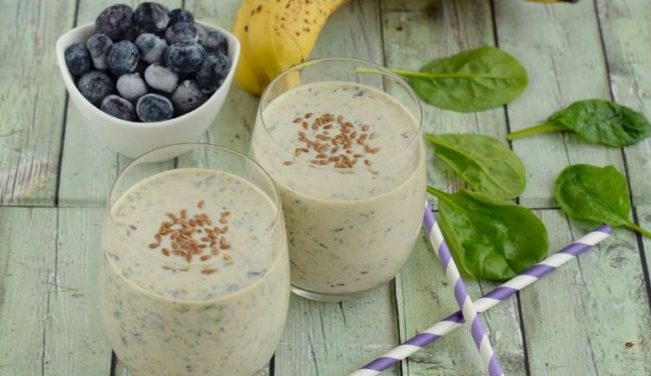The holidays are a time of joy and celebration. For many of us, however, they also bring stress, seasonal sadness, and maybe even a few extra pounds. Why not push the reset button on the holiday health by starting your day with a refreshing mood boost smoothie?
This boost smoothie recipe features mood-supportive nutrients will keep you feeling satisfied. It may be easier to pass by the cookie plate and skip the regrets.
Frozen fruits and veggies are a great start to any smoothie, as they bring the signature frosty bite to your drink without the extra water of melting ice cubes. They are also a great addition to any good mood food, as diets higher in fruits and vegetables bear a lower incidence of a low mood [1]. For this boost smoothie, we recommend blueberries and spinach as your fruit and veg, because of their individual mood-boosting properties.
Why Blueberries for Boosting Mood?
With more antioxidants than any other common fruit or vegetable, blueberries really pack a brain-boosting punch. They contain a high concentration of a particular type of antioxidant called a flavonoid (more specifically anthocyanin and flavonol), which can help to regulate mood, improve memory, and protect the brain from some physical aging [2]. All of these factors are important when it comes to mood. The aging brain is more vulnerable to mental health challenges [3].
Antioxidants found in blueberries may even reverse some age-related deficits in spatial working memory and short-term memory, centered in the hippocampus [2]. A recent animal study also suggested that the chemicals and antioxidants in blueberries may help to promote healthy inflammatory response, and restore normal neurotransmitter balance and oxidative stress in the brain [4].
Why Spinach for Boosting Mood?
Spinach is also a superfood as it contains a number of beneficial nutrients. Spinach contains vitamins A and K, as well as fiber to keep your digestive system running smoothly. When it comes to mood and the brain, however, we are celebrating spinach for its folate and magnesium content.
Nutritional scientists have shown time and again that typically, individuals with a chronically low mood have lower serum levels of folate and dietary folate intake [5]. This relationship alone does not prove causation. However, when we look into the relationship between folate and healthy neurotransmitter synthesis, it makes sense that less folate in the diet will likely lead to reduced serotonin synthesis and availability in the brain. In fact, folate supplementation can support efficacy of more traditional treatments [5].
Spinach also contains the mineral magnesium. About two-thirds of the American population are likely magnesium deficient, and magnesium is necessary for more than 325 enzymatic reactions in the body [6]. Some of those reactions can directly affect your mood. For example, magnesium is a cofactor for the COMT enzyme. COMT is involved in the metabolism of the neurotransmitters dopamine, norepinephrine, and epinephrine [6].
Magnesium and folate should always walk hand-in-hand. Many people who have experienced folate deficiency also experienced the downstream symptoms of mood imbalance. This is likely from insufficient or dysregulated neurotransmitter synthesis. Once the methylation cycle is stable from supplementation, adequate magnesium levels are still important. The body and brain require magnesium to process the increase in neurotransmitters [6].
Why Flax Seeds for Boosting Mood?
Flax seeds are also an excellent source of magnesium. Another reason they are in this mood-boosting smoothie is because of their omega-3 fatty acid content. Flax is available as whole seeds or as flax meal (which is less likely to stick in your teeth).
Omega-3 fatty acid are associated with better mental health and several treatment studies have indicated mood benefits with omega-3 supplementation [7]. An association between omega-3 fatty acid deficiency and coronary artery disease has also been suggested as an explanation for the link between cardiovascular health and mood [7]. Omega-3s are more typically associated with fish and seafood, but fish would probably be an unwelcome ingredient in a fruity breakfast drink.
Why Yogurt for Boosting Mood?
Adding protein to your mood boost smoothie is a great way to make sure you stay feeling satisfied for longer after your meal. One excellent, natural protein source that will add creamy texture, tang, and probiotics to your smoothie is a plain, organic yogurt.
If you are averse to or sensitive to dairy, of course, you can substitute with a non-dairy yogurt for a similar probiotic dose. You do want to be careful reading yogurt labels because high levels of sugar are often hidden by tangy flavor. This is why we suggest always buying plain and adding your own sweetener and fruit.
Although you may generally associate probiotics with your digestive system, they may actually be working to help balance your mood as well. Research shows that the gut and brain are closely connected through the gut-brain axis, a biochemical signaling relationship between the enteric nervous system in the digestive tract and the central nervous system, which includes the brain [8].
The brain and gut are connected by the vagus nerve, the longest nerve in the body, and a healthy gut is actually responsible for making many of the same neurotransmitters produced by the brain (such as serotonin, dopamine, and GABA). In fact, it has been estimated that up to 90% of circulating serotonin is made in the digestive tract [8]. You can read more about supporting your gut with probiotics here. Evidence indicates that supporting the health of your gut will also support the health of your mind and mood.
Why Matcha Powder for Boosting Mood?
Your mood boost smoothie will already have a hint of green from the spinach you’ll add, but why not make it just a little greener? Matcha green tea powder will put a pep in your step and give you a boost of calm, focused energy to start your day.
The chemical constituents of green tea that have long supported its reputation as a brain food are caffeine, the amino acid L-theanine, and epigallocatechin gallate (EGCG) [9]. Caffeine alone can improve performance on long-duration cognitive tasks and alertness, arousal, and vigor [9].
L-Theanine alone can help with relaxation, calmness, and reducing tension. EGCG has even been shown to have some fat-burning properties. Together, L-theanine and caffeine benefit sustained attention, memory, and suppression of distraction, and L-theanine counteracts the jitters that caffeine can cause [9].
Mood Boost Smoothie Recipe (makes 1 smoothie/smoothie bowl)
- ½ cup blueberries
- ½ cup spinach
- ½ cup yogurt
- 1 tablespoon matcha powder
- 1 tablespoon flax meal (or whole seeds)
- (optional) A drizzle of honey or agave syrup to taste (about 1 Tbsp)
- (optional) Purified water or fruit juice to taste (about 1 Tbsp for a smoothie bowl or ½ cup for a drinkable smoothie)
By blending these ingredients, you’ll have a rather thick smoothie that is quite tart (especially if you forego the sweetener). If you prefer a smoothie bowl, you can pour these ingredients, blended, into a bowl and top with an extra drizzle of honey, a sprinkle of granola, sliced fruit like bananas or strawberries, and maybe some dried coconut for texture.
If you prefer to drink your mood boost smoothie, you’ll likely want to add more liquid to get the consistency of your preference. By adding a small amount of fruit juice (orange or apple) you can both sweeten and thin with the same liquid. Otherwise, a drizzle of honey or agave syrup makes a great sweetener, and water works just fine to thin the smoothie to your desired consistency. Add just a few tablespoons at a time while you blend.
References:
- https://www.sciencedirect.com/science/article/abs/pii/S0899900715003974
- https://www.cambridge.org/core/journals/british-journal-of-nutrition/article/impact-of-fruit-flavonoids-on-memory-and-cognition/89B1CBDD1DA9A70D21CEBB257B9452FE
- https://www.tandfonline.com/doi/full/10.31887/DCNS.2013.15.1/esibille
- https://journals.plos.org/plosone/article?id=10.1371/journal.pone.0160923
- https://www.sciencedirect.com/science/article/abs/pii/S0022395617305927
- http://www.immh.org/article-source/2016/11/17/magnesium-the-missing-link-in-mental-health
- https://ajp.psychiatryonline.org/doi/full/10.1176/ajp.2006.163.6.969
- https://www.health.harvard.edu/mind-and-mood/probiotics-may-help-boost-mood-and-cognitive-function
- https://www.ingentaconnect.com/content/ben/cpd/2017/00000023/00000019/art00012

